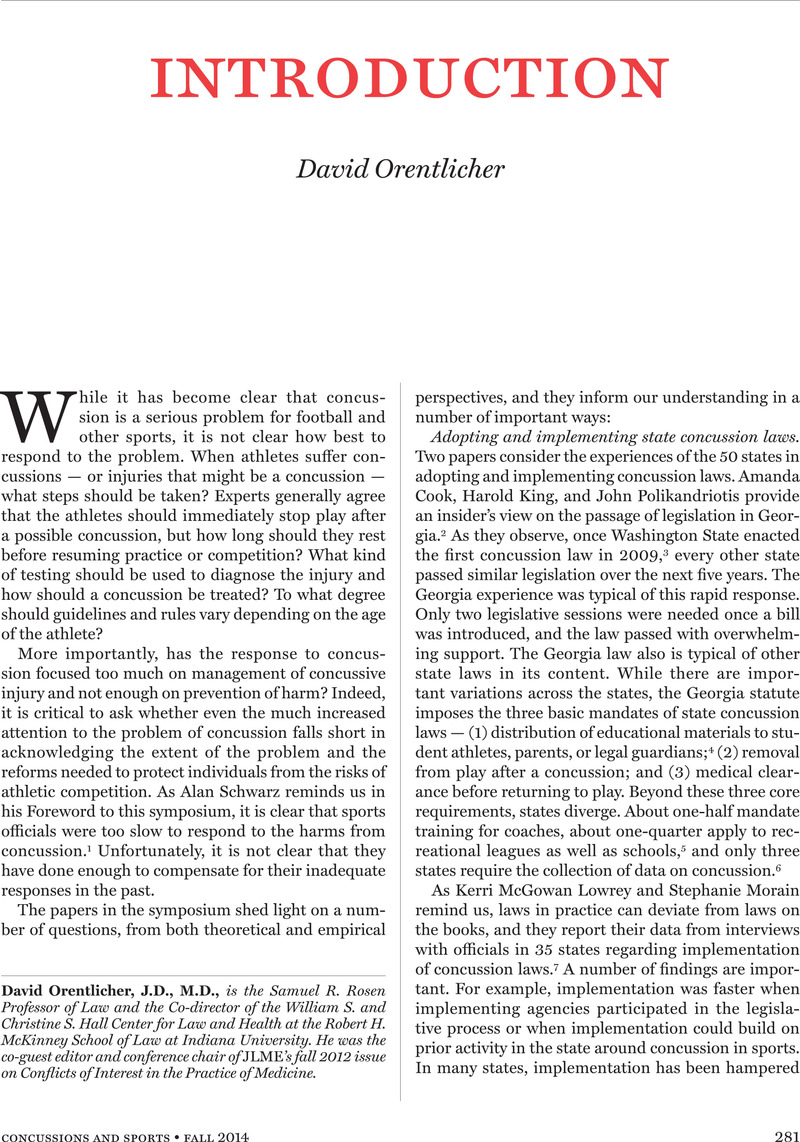No CrossRef data available.
Article contents
Abstract
An abstract is not available for this content so a preview has been provided. Please use the Get access link above for information on how to access this content.

- Type
- Introduction
- Information
- Copyright
- Copyright © American Society of Law, Medicine and Ethics 2014
References
Schwarz, A., “Foreword,” Journal of Law, Medicine & Ethics 42, no. 3 (2014): 280. The medical profession also was slow to respond to the problem. Orentlicher, D. David, W. S., “Concussions in Football: Failures to Respond by the NFL and the Medical Profession,” Florida International University Law Review 8, no. 1 (2013): 17–30.Google Scholar
Cook, A. King, H. Polikandriotis, J. A., “Where Do We Go from Here? An Inside Look into the Development of Georgia's Youth Concussion Law,” Journal of Law, Medicine, & Ethics 42, no. 3 (2014): 284–289.CrossRefGoogle Scholar
The Washington statute was named for Zachary Lystedt, who in 2006, at the age of 13, suffered a severe brain injury while playing football. Id.Google Scholar
A few states do not require information disclosures. Baugh, C. Kroshus, E. Bourlas, A. P. Perry, K. I., “Requiring Athletes to Acknowledge Receipt of Concussion-related Information and Responsibility to Report Symptoms: A Study of the Prevalence, Variation, and Possible Efficacy,” Journal of Law, Medicine, & Ethics 42, no. 3 (2014): 297–313. Moreover, states vary in terms of the content of the information that must be disclosed. Id.CrossRefGoogle Scholar
Even when recreational leagues are covered, the law may apply only in part. Georgia imposes its educational requirement on recreational leagues, but not its removal from play or medical clearance requirements. See Cook, et al supra note 2.Google Scholar
Lowrey, K. M. Morain, S. R., “State Experiences Implementing Youth Sports Concussion Laws: Challenges, Successes, and Lessons for Evaluating Impact,” Journal of Law, Medicine & Ethics 42, no. 3 (2014): 290–296.CrossRefGoogle Scholar
Id Baugh, et al also found that many states go beyond the statutory minimums. For example, “although New York is the only state with a law that requires return to school information be provided, there were 23 other states that included information about returning to school in their concussion education materials.” Baugh, et al supra note 4.Google Scholar
Baugh, C. Kroshus, E. Daneshvar, D. H. Stern, R. A., “Perceived Coach Support and Concussion Symptom-Reporting: Differences between Freshmen and Non-Freshmen College Football Players,” Journal of Law, Medicine, & Ethics 42, no. 3 (2014): 314–322.CrossRefGoogle Scholar
See Baugh, et al Supra note 4 If athletes make an informed decision whether to accept the risks of sport, then teams may thereby limit their liability for injuries to the players. Id.Google Scholar
Bachynski, K. Goldberg, D., “Youth Sports & Public Health: Framing Risks of Mild Traumatic Brain Injury in American Football and Ice Hockey,” Journal of Law, Medicine & Ethics 42, no. 3 (2014): 323–333.CrossRefGoogle Scholar
Robeson, R. King, N. M. P., “Loss of Possession: Concussions, Informed Consent and Autonomy,” Journal of Law, Medicine & Ethics 42, no. 3 (2014): 33–343.CrossRefGoogle Scholar
See Bachynski, Goldberg, , supra note 16. In another context – that of spanking and other corporal punishment of children – I have discussed societal tendencies to undervalue children and overvalue pain. Both of those tendencies may also be at work with concussion and sports. For the earlier articleGoogle Scholar
see Orentlicher, D., “Spanking and Other Corporal Punishment of Children by Parents: Undervaluing Children, Overvaluing Pain,” Houston Law Review 35, no. 1 (1998): 147–185.Google Scholar
Cantu, R. C. Hyman, M., Concussion and Our Kids: America's Leading Expert on How to Protect Young Athletes and Keep Sports Safe (Boston: Houghton Mifflin Harcourt, 2012): At 144–145. Cantu also would ban heading in soccer until players reach the age of 14. Id., at 40.Google Scholar




